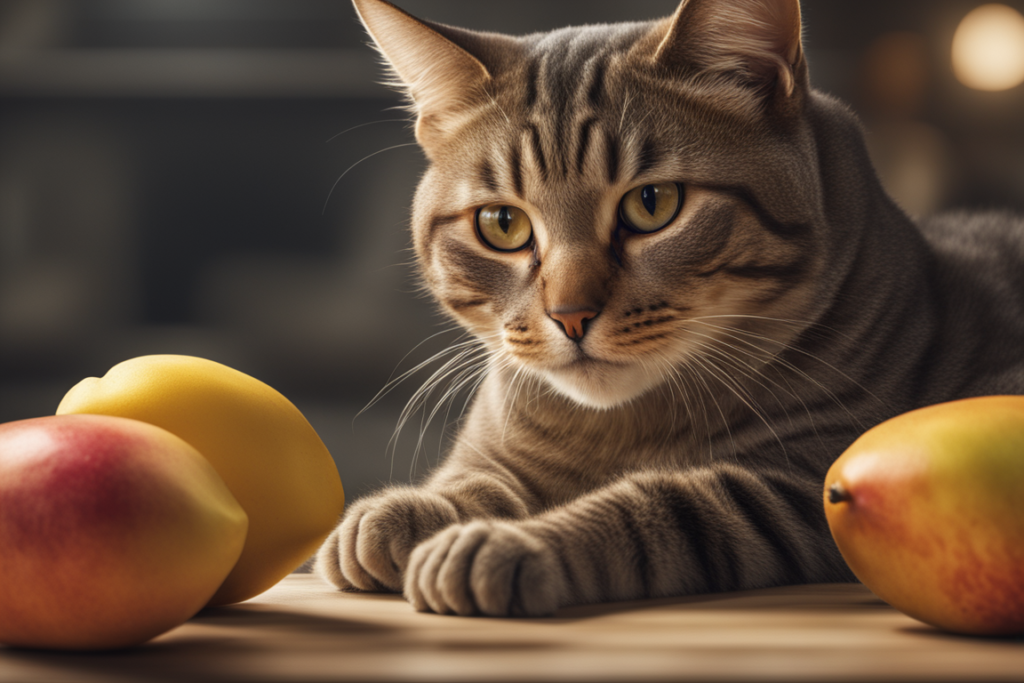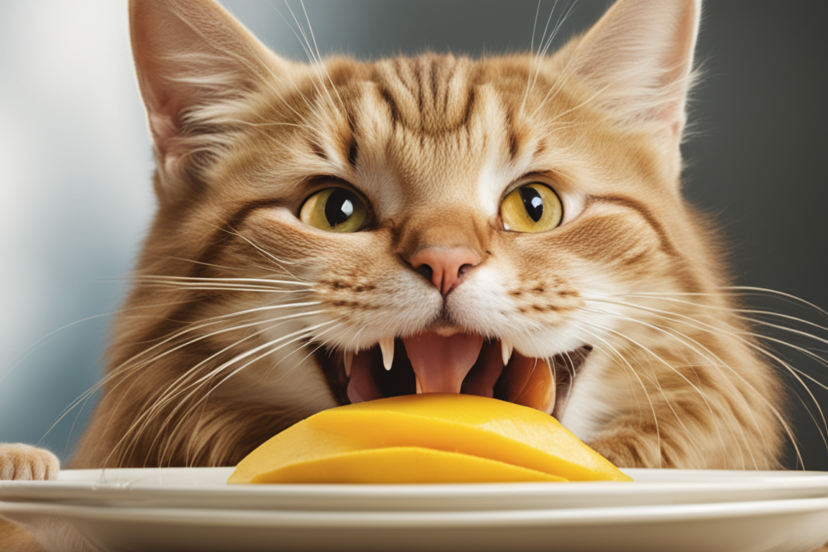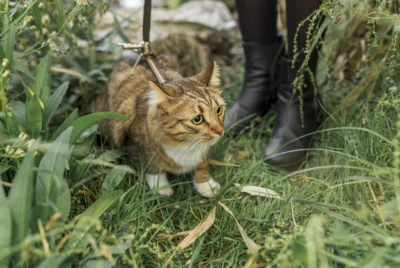Can Cats Eat Mango? A Guide to Sharing This Tropical Treat
Mango is a popular summertime fruit humans enjoy worldwide for its sweet and creamy flesh. But can cats eat mango, too? Cats may be curious about this bright yellow tropical fruit, like feline companions like us.
The good news is that cats can eat mango, but only in moderation and with proper preparation.
While they may eat mangos, the only fruits cats can eat are limited as some may pose risks to their health or may be a choking hazard. To ensure their health, a good quality cat food is still the best option for feeding your feline friends.
Sharing Human Food with Cats Like Mango as an Occasional Treat
While a diet of mainly cat food is still best, an occasional small piece of mango can make a fun and nutritious snack or treat for most cats. As with any human food, it’s important to introduce mango slowly and watch for any signs of upset or allergy.
Mangos’ nutritional benefits can supplement normal cat food in small doses, especially in the summer. Just be sure not to replace cats’ regular meals with too much fruit, which offers little nutritional value compared to pet foods.
Vitamin C in Mango Is A Potential Boost for Healthy Cats
Mango has lots of Vitamin C, which acts like an antioxidant to help protect a cat’s immune system. Cats are supposed to get around 15 mg of Vitamin C each day. One cup of fresh mango has 40 mg of it!
Even a little piece could help supplement the excellent stuff cats get in their food to fight germs, mainly when viruses and bacteria spread more easily in warmer weather. The Vitamin C in mango may help cats feel healthier.
Fresh vs. Dried Mango
When considering giving your cat a mango treat, fresh mango is better than dried mango. Dried mango might be easier to store and carry, but the drying process removes moisture and makes the natural sugars more concentrated.
For cats, that means dried mango is more likely to upset their bellies. Fresh mango is softer and has a similar texture and wetness to what wild cats would normally eat. Fresh mango also tends not to cause tummy troubles as much.

Understanding Your Cat’s Diet
While fruits like mango offer some vitamins, most of a cat’s daily nutrition should come from high-quality cat food. Commercial cat food is specially formulated to provide a balanced ratio of protein, vitamins, minerals, and other micronutrients in digestible forms.
One or two small pieces of fresh fruit per week can make for an enjoyable snack but should not replace wet or dry cat food meals. Balance is critical to keeping feline friends happy and healthy.
The Role of Mango in a Cat’s Diet as Occasional Treat vs. Nutritional Staple
Mangos are best considered an occasional treat rather than part of the normal daily diet. While mangos do contain nutrients, they lack the protein and other important nutrients cats need daily for energy, growth, and overall health.
The natural sugars in fruits alone don’t contain most of the macronutrients and other good stuff complete, balanced cat food provides. At most, one tiny piece of fresh mango 1-2 times a week is enough as a low-calorie snack between regular meals of high-quality cat food. Too much fruit risks upset tummies or filling cats up when animal protein is really what they require.
Removing Pits and Skin Before Sharing Mango
When preparing mango for cats, peeling the fruit and removing the large seed or pit inside is essential. Mango pits contain a toxin called cyclopropenoid acids that can cause stomach upset in some animals if ingested.
The skin of the fruit can also be tricky for cats to digest. For safety, peel off the green skin with a knife, then slice or dice the bright yellow flesh away from the wide seed before sharing. This removes risks while allowing your feline friend to enjoy the sweet pulp.
Also read: Can Cats Have Beef Jerky? A Comprehensive Guide for Cat Lovers
How Much Mango is Safe for Cats?
As with any new food, start by offering cats a tiny piece, about half the size of their pinky nail. Some cats are more sensitive than others; too much of a prosperous new food could cause digestive upsets. Watch for signs of intolerance like vomiting, diarrhea, or loss of appetite after eating mango.
If all is well, a single teaspoonful of cleanly peeled and seeded fresh mango per 5-10 lbs of body weight is a reasonable occasional portion size for most cats. Adjust amounts based on individual tolerance.

Natural Sugars and Cat Digestion
The natural sugars called fructose in mango are usually okay for cats to eat in small amounts. However, overeating at once could cause diarrhea in cats with sensitive tummies.
Introduce mango to your cat gradually and watch how their body reacts. A cat’s belly is not as good at handling a lot of fruit as a person’s belly is. Give your cat a few tiny pieces they’ve tasted before to let the sugars digest without upsetting their tummy. Going slow is essential when sharing new foods with cats.
Choking Hazards and Preparing Mango to Prevent Accidents
Mango pieces should be no bigger than about half a centimeter square to reduce the risk of choking. Cats can’t chew or swallow large bits as well as people can.
It’s important to watch cats closely when giving them mango in case they accidentally suck in or choke on a piece that’s too big. Cutting mango into very small pieces helps avoid problems. Mangoes are slippery so bigger chunks could get stuck in a cat’s throat if not cut up right for their small mouths. Taking steps to prevent danger is important when cats eat any human food.
Cat-Safe Fruits and Exploring Healthy, Fun Alternatives
While mango is a tasty snack, there are several other fruits that cats can enjoy now and then instead. Bananas are a fiber-rich option. Berries like blueberries and strawberries contain antioxidants.
Watermelon without seeds is a hydrating summer favorite. Small slices of cantaloupe or honeydew melon are also light and nutritious choices. See which fruits your cat likes best as an occasional snack between meals of their nutritionally balanced cat food. Slowly introduce fruits and watch closely for any signs of an upset tummy.
A Balanced Diet is Key Means Prioritizing Cat Food Over Fruit Treats
Even though fruits can provide some good nutrients, store-bought cat food made by companies to give cats all the balanced nutrition they need should still be the central part of a cat’s everyday meals. Look for brands that meet the Association of American Feed Control Officials’ rules for complete and healthy food. Also, talk to your vet and get their advice on the best cat food.
Fruits are meant as a snack occasionally, not something to replace cat food or be part of most meals. Cat food for cats gives them all the essential protein, fats, vitamins, and minerals they need to feel good. Sticking to this balanced diet where cat food stays the priority is what keeps cats truly happy and healthy overall.

Can Cats Eat Mango? Yes, in Moderation!
Most cats can sometimes enjoy small pieces of fresh mango as a special treat. If owners introduce mango carefully and in small amounts, it can be a healthy snack for cats in summer. It’s essential to watch cats closely the first few times they try mango to see if it upsets their belly. Only give a few tiny pieces to prevent tummy troubles from sugars or a texture cats may not like. With time and small portions, mango can be a yummy seasonal treat shared between people and pets.
Cutting mango into super small bits and removing all the thick skin and seeds makes it low risk for cats. As long as owners are watchful and do not feed too much at once, mango’s vitamins offer cats a notable nutrition boost now and then when temperatures rise.
Also read: Can Cats Eat Bacon Safely? A Guide to Keeping Your Cat Healthy
Making Informed Choices For Your Feline Companion’s Well-Being
It’s very important to always prioritize your cat’s health and happiness when sharing foods like mangoes. Talk to your vet if you ever have any questions about what foods are okay or how much is too much, or if you notice how your cat reacts differently than other cats.
Cat food made just for cats by companies should still be the main part of a balanced diet for good nutrition. But learning more about what’s best to feed from reliable sources and keeping close watch on your own cat means you can sometimes include an approved snack as a treat for both of you too. Keeping your furry friend feeling their best has to be the top priority when it comes to these choices.
Mango for Fun, Cat Food for Nutrition
To wrap it up, tiny bites of mango here and there can be a good snack for cats on hot summer days if you do it right. You need to give them only a little at a time and introduce them slowly to their diet. But store-bought cat food, made special for cats with what they need nutritionally, should still be most of what’s in a cat’s meals every day.
Following these simple rules about cat food, along with a fruit treat every now and then, will help ensure that your furry friend stays happy and healthy for many years to come.
Even though mangos are fun and tasty for people, what really matters is having a balance. And that means cat food provides what cats need daily to grow up strong and feel good all the time, with mango just being an extra sometimes.
Being careful like this means tropical fruits can definitely be a small part of taking good care of your cat. Let them eat fruit like mangos but for a tasty treat only, not for their main nutritional source.




